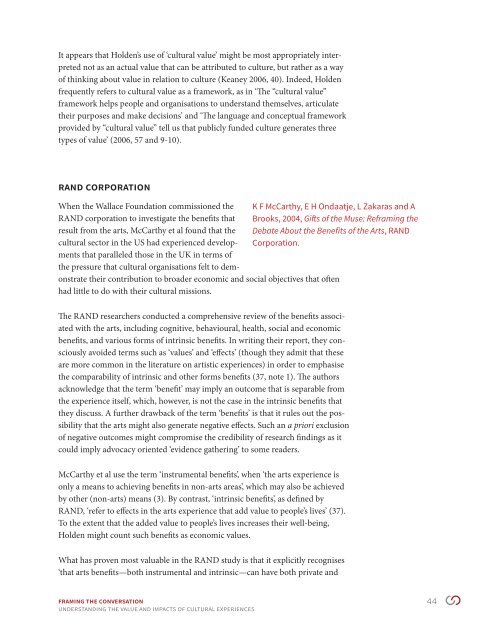aceUVi
aceUVi
aceUVi
You also want an ePaper? Increase the reach of your titles
YUMPU automatically turns print PDFs into web optimized ePapers that Google loves.
It appears that Holden’s use of ‘cultural value’ might be most appropriately interpreted<br />
not as an actual value that can be attributed to culture, but rather as a way<br />
of thinking about value in relation to culture (Keaney 2006, 40). Indeed, Holden<br />
frequently refers to cultural value as a framework, as in ‘The “cultural value”<br />
framework helps people and organisations to understand themselves, articulate<br />
their purposes and make decisions’ and ‘The language and conceptual framework<br />
provided by “cultural value” tell us that publicly funded culture generates three<br />
types of value’ (2006, 57 and 9-10).<br />
RAND Corporation<br />
K F McCarthy, E H Ondaatje, L Zakaras and A<br />
Brooks, 2004, Gifts of the Muse: Reframing the<br />
Debate About the Benefits of the Arts, RAND<br />
Corporation.<br />
When the Wallace Foundation commissioned the<br />
RAND corporation to investigate the benefits that<br />
result from the arts, McCarthy et al found that the<br />
cultural sector in the US had experienced developments<br />
that paralleled those in the UK in terms of<br />
the pressure that cultural organisations felt to demonstrate<br />
their contribution to broader economic and social objectives that often<br />
had little to do with their cultural missions.<br />
The RAND researchers conducted a comprehensive review of the benefits associated<br />
with the arts, including cognitive, behavioural, health, social and economic<br />
benefits, and various forms of intrinsic benefits. In writing their report, they consciously<br />
avoided terms such as ‘values’ and ‘effects’ (though they admit that these<br />
are more common in the literature on artistic experiences) in order to emphasise<br />
the comparability of intrinsic and other forms benefits (37, note 1). The authors<br />
acknowledge that the term ‘benefit’ may imply an outcome that is separable from<br />
the experience itself, which, however, is not the case in the intrinsic benefits that<br />
they discuss. A further drawback of the term ‘benefits’ is that it rules out the possibility<br />
that the arts might also generate negative effects. Such an a priori exclusion<br />
of negative outcomes might compromise the credibility of research findings as it<br />
could imply advocacy oriented ‘evidence gathering’ to some readers.<br />
McCarthy et al use the term ‘instrumental benefits’, when ‘the arts experience is<br />
only a means to achieving benefits in non-arts areas’, which may also be achieved<br />
by other (non-arts) means (3). By contrast, ‘intrinsic benefits’, as defined by<br />
RAND, ‘refer to effects in the arts experience that add value to people’s lives’ (37).<br />
To the extent that the added value to people’s lives increases their well-being,<br />
Holden might count such benefits as economic values.<br />
What has proven most valuable in the RAND study is that it explicitly recognises<br />
‘that arts benefits—both instrumental and intrinsic—can have both private and<br />
Framing the Conversation 44<br />
UNDERSTANDING the value and impacts of cultural experiences


